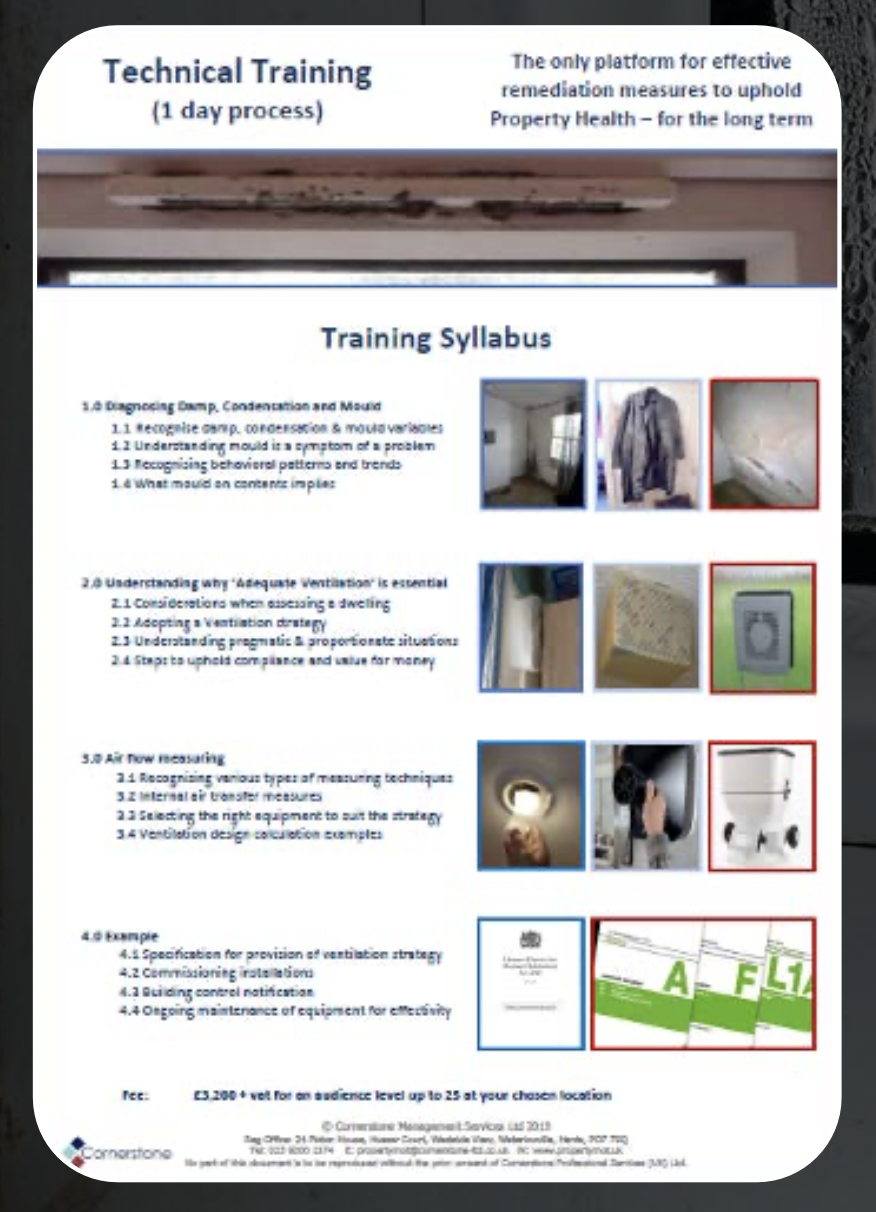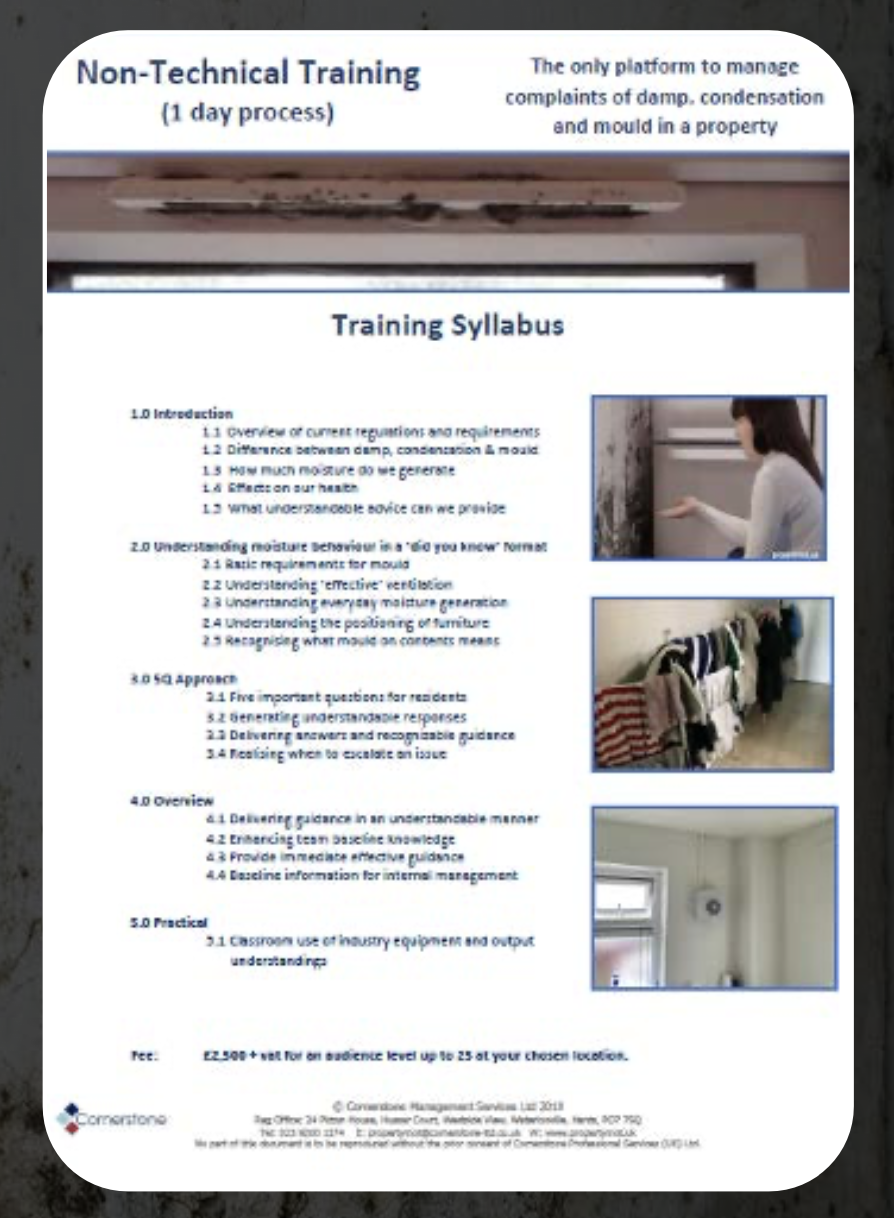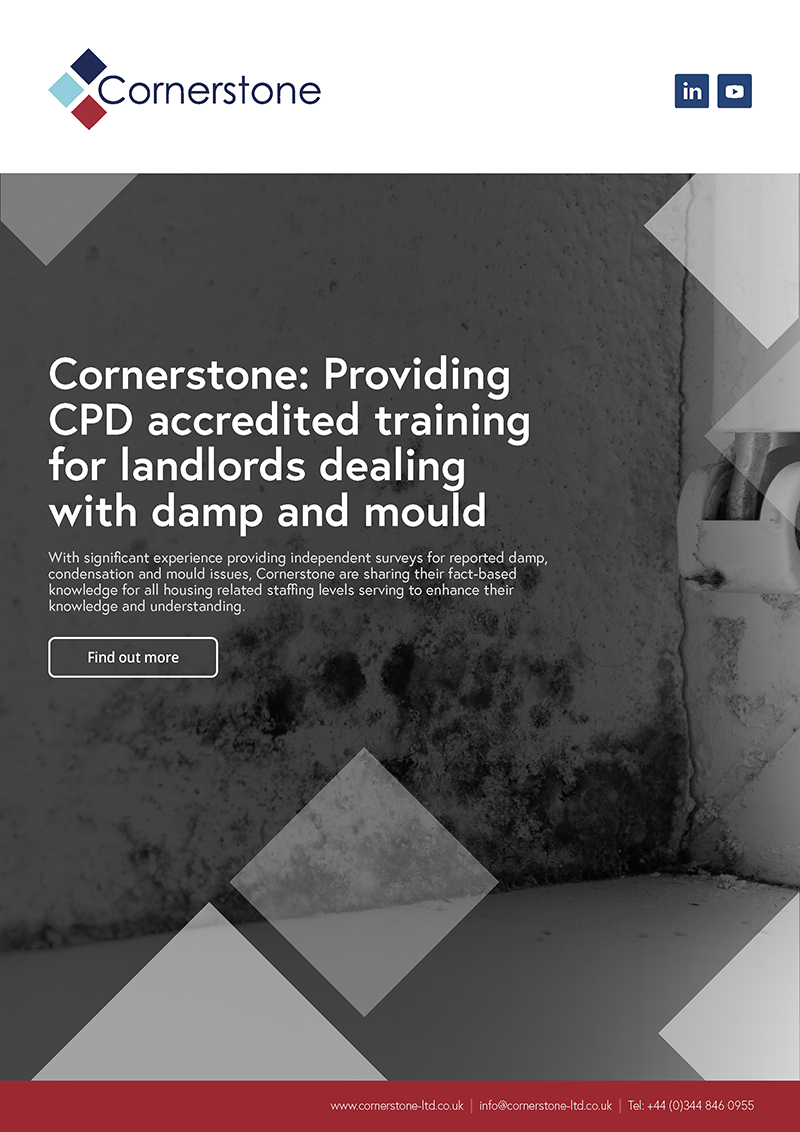With significant experience providing independent surveys for reported damp, condensation and mould issues, Cornerstone are sharing their fact-based knowledge for all housing related staffing levels serving to enhance their knowledge and understanding
Why does mould develop?
Cornerstone provide a clear understanding of what, where, and why mould develops in structures, on furniture and indeed clothing, with a recognised description of the defined root causes of these symptoms.
This clear understanding has resulted in better decision- making aligned with any necessary repairs or remediations by respective skilled trades.
However, with constant year-on-year damp, condensation, and mould in many homes, it could be argued our approach regarding how they are assessed for these reported issues requires a reset.
That would underpin recognising ‘blame’ is not an option and, can be replaced with ‘did you know’ since many residents may not be aware of the impact some everyday activities have on the internal conditions as a whole.
Hence, armed with understandable guidance in a recognisable manner, a significant change in thought processes when commencing an investigation into a reported problem will lead to improved landlord and tenant relations.
The question of whether landlords are doing enough is noted, but they may well be doing enough within their infrastructure and existing knowledge level recognizing that what they don’t know…..they don’t know!
There remains a strong reliance on expert trades to deliver the necessary ‘improvement’ not only in accordance with regulatory compliance but also with a cost-effective expected outcome.
However, it is Cornerstone’s experience that this has not always been the case, with many of their investigations being undertaken for repeat problems; hence, a ‘reset’ is a recommended consideration.
Are we ready for Awaab’s Law?
The first phase of this new law comes into effect in October and essentially places a greater response timeframe to investigate and repair emergency hazards within 24 hours.
Whilst this may appear to be a key undertaking, are we ready to change our decision making to assist the reduced timelines?
Why? Because our extensive experience clearly shows multiple attempts to resolve in particular damp, condensation and mould related issues have not solved the problems and in a number of cases, have served to worsen the issue due to a lack of understanding of what exactly contributes to damp and mould.
We are all tasked with resolving a problem such that, it can only be a gap in knowledge for why these problems continue to be experienced across the UK throughout the year.
Did you know:
Damp and Mould are two separate issues whereby damp tends to show itself as discolouring, cracking, blistering etc and mould is simply a ‘symptom’ of a problem and develops in areas of reduced disturbance alongside available key nutrients.
Hence, it is not uncommon for occupants to believe they are in a wet structure where mould has developed and, is not the case in the majority of investigations.
If the atmospheric conditions are suitable for a number of days, mould can develop in the absence of wet or damp buildings.
Plus, mould on contents items, including furniture and clothing, is likely due to periods of atmospheric moisture and not structural damp.
Opening a window will not readily clear condensation and is regarded as a ‘purge’ event. Overnight condensation can be considered a ‘normal’ phenomena since our warm breathing comes into contact with colder glass leading to the visual beads of moisture with it recommended they are wiped clean to reduce the internal moisture load.
Why? because our everyday activities and breathing generates more water vapour than a wet structure would.
Close the bathroom door after use. Why? Because moisture laden air in the bathroom (or kitchen) increases the vapour pressure such that, via an open door the atmospheric moisture will circulate the dwelling as it is at a lower vapour pressure resulting in it coming into contact with cooler areas of the structure and enter open wardrobes etc.
Drying clothes indoors can release between 4 – 5 litres of moisture into the air and, whilst this is regarded as a key reason for mould, it would need to accompanied by a host of other contributory elements for it to be accurately defined as such.
Mould in one room will release spores to circulate the dwelling hence, a key action should be to remove the initial outbreak as soon as it is discovered.
Why? Because it initially aids confirming the likely source of an outbreak i.e. mould in the bedroom actually came from the bathroom.
Do not use bleach on mould. Why? Because mould has a root system called Mycellium and tends to migrate into the surface it resides on. Bleach will uphold a sufficient task with leaving the surface in a very clean condition but, it does not deal with the mycelium such that, if the overriding symptoms are not accurately determined, the mould will return within a quicker timeframe that if it was the initial outbreak.
Do not spray mould with a cleaning agent. One cubic-inch of mould can contain up to 10 million spores hence, spraying them can serve to disrupt the outbreak and release signific ant volumes of spores that will readily circulate the dwelling.
Spray a cloth and wipe the surface clean to reduce this potential.
Simple knowledge = SMART Knowledge
For a defined way forward, Cornerstone is of the opinion a designated uniform framework is a major consideration for upholding a consistent approach to these reported problems within an organization commencing upon the receipt of a complaint through to its successful and certified remediation.
Why?
Because we are still dealing with damp, condensation and mould in 2025.
And, with a recognised drive for net zero, if we sought to implement such recognised aspects in our homes today without a defined understanding of the structure type, geographical location, current permeability (leakiness) and occupancy levels, the problems would, in our opinion escalate.
Cornerstone is sharing its knowledge with recognized CPD Accredited training combining damp, condensation and mould plus, ventilation. Why? Because 90% of our independent surveys to date for reported damp and mould have demonstrated a dry building alongside either defective or inadequate ventilation being a root cause.
The training is aimed at call centre administrative staff through to technical related surveyors within organisations covering an initial 5Q approach whereby five key questions divulge a significant understanding of the issue.
This approach is supported with initial simplistic and understandable actions to try in advance of a formal complaint being escalated.
The guidance in a ‘did you know’ format rather than a ‘blame’ aspiration can serve to improve the chances for improvements being undertaken and certainly the landlord – tenant relationship in regard to the health of the home.




